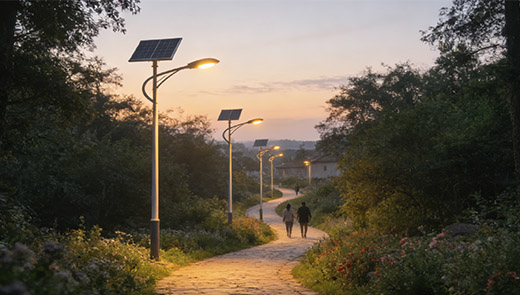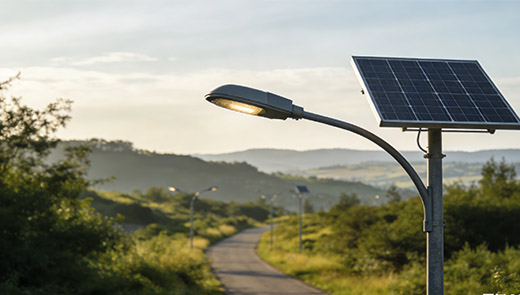Aluminum Embedded Solar Road Studs: Illuminating the Path Towards Safer Roads
Aug 02, 2023
In the continuous pursuit of enhancing road safety and sustainability, innovative technologies have emerged to revolutionize the way we approach transportation infrastructure. One such advancement is the utilization of aluminum embedded solar road studs, which not only serve as navigational aids but also contribute to energy conservation and reduced environmental impact. In this article, we delve into the structure, installation conditions, and the advantages and disadvantages of these remarkable solar-powered road studs.
1. Structure of Aluminum Solar Road Studs: Aluminum embedded solar road studs are compact, self-contained units designed to be integrated into road surfaces. They typically consist of several key components:
a. Outer Casing: The outer shell is usually constructed from durable and corrosion-resistant aluminum, which ensures the longevity and robustness of the stud. This casing also provides protection for the internal components against harsh weather conditions, heavy traffic loads, and other environmental factors.
b. Solar Panel: An embedded solar panel sits atop the road stud, capturing sunlight during the day to convert it into electrical energy. This energy is stored in a rechargeable battery within the stud for nighttime illumination.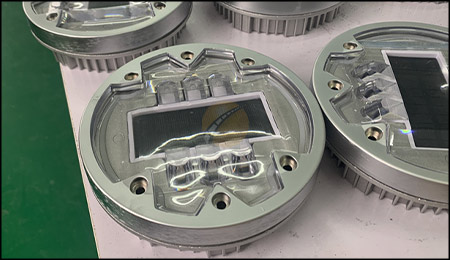 c. LED Lights: High-intensity LEDs are strategically placed within the stud, creating a bright and highly visible light source. These LEDs are energy-efficient and have a long lifespan, making them ideal for continuous use.
c. LED Lights: High-intensity LEDs are strategically placed within the stud, creating a bright and highly visible light source. These LEDs are energy-efficient and have a long lifespan, making them ideal for continuous use.
d. Photocell: A photocell, also known as a light sensor, detects ambient light levels. When the surrounding light diminishes to a certain threshold, the LED road stud lights automatically activate, providing illumination for improved visibility.
2. Installation Conditions and Advantages/Disadvantages:
a. Installation Conditions: The successful deployment of aluminum solar road studs requires careful consideration of various factors:
- Location: Solar road studs are most effective in areas with consistent exposure to sunlight. Installing them in shaded or tree-covered regions might impact their ability to gather sufficient solar energy.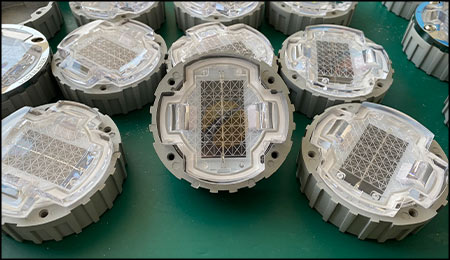 - Road Surface: The road surface should be flat, even, and properly prepared to ensure the studs are embedded securely. Proper installation is crucial to withstand heavy traffic loads and prevent damage.
- Road Surface: The road surface should be flat, even, and properly prepared to ensure the studs are embedded securely. Proper installation is crucial to withstand heavy traffic loads and prevent damage.
- Maintenance: While these studs are designed to be low-maintenance, periodic inspections are necessary to ensure they remain fully functional. Cleaning the solar panels and checking for any physical damage or malfunctioning components is essential.
b. Advantages: The utilization of aluminum embedded solar road studs offers a range of advantages, contributing to safer and more sustainable road infrastructure:
- Enhanced Visibility: Solar road studs provide superior visibility during low-light conditions, such as fog, rain, or nighttime. This improves road safety by helping drivers navigate more effectively.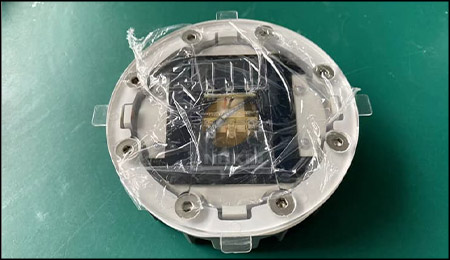 - Energy Efficiency: By harnessing solar energy, these studs reduce the reliance on traditional grid electricity, leading to energy savings and lower operational costs.
- Energy Efficiency: By harnessing solar energy, these studs reduce the reliance on traditional grid electricity, leading to energy savings and lower operational costs.
- Environmentally Friendly: Solar road studs contribute to a greener environment by reducing carbon emissions associated with traditional lighting methods.
- Durability: The aluminum construction ensures durability, making the studs resistant to corrosion, extreme temperatures, and heavy loads.
c. Disadvantages: While the benefits are substantial, there are a few considerations to keep in mind:
- Initial Costs: The installation cost of solar road studs, including the purchase of materials and installation processes, can be higher than conventional road marking methods.
- Dependent on Sunlight: The effectiveness of solar road studs relies on adequate sunlight exposure. Extended periods of cloudy weather or limited sunlight can potentially impact their performance.
3. Summary: Aluminum embedded solar road studs stand at the intersection of innovation and road safety. Their intricate design, combining aluminum casing, solar panels, LEDs, and photocells, offers a multifaceted solution to the challenges faced by conventional road lighting methods. While installation conditions and some drawbacks exist, the advantages in terms of enhanced visibility, energy efficiency, and environmental sustainability make these solar road studs a promising addition to modern transportation infrastructure. As technology continues to evolve, we can anticipate further refinements and improvements in solar road stud design, contributing to safer and more sustainable roadways for generations to come.
1. Structure of Aluminum Solar Road Studs: Aluminum embedded solar road studs are compact, self-contained units designed to be integrated into road surfaces. They typically consist of several key components:
a. Outer Casing: The outer shell is usually constructed from durable and corrosion-resistant aluminum, which ensures the longevity and robustness of the stud. This casing also provides protection for the internal components against harsh weather conditions, heavy traffic loads, and other environmental factors.
b. Solar Panel: An embedded solar panel sits atop the road stud, capturing sunlight during the day to convert it into electrical energy. This energy is stored in a rechargeable battery within the stud for nighttime illumination.

d. Photocell: A photocell, also known as a light sensor, detects ambient light levels. When the surrounding light diminishes to a certain threshold, the LED road stud lights automatically activate, providing illumination for improved visibility.
2. Installation Conditions and Advantages/Disadvantages:
a. Installation Conditions: The successful deployment of aluminum solar road studs requires careful consideration of various factors:
- Location: Solar road studs are most effective in areas with consistent exposure to sunlight. Installing them in shaded or tree-covered regions might impact their ability to gather sufficient solar energy.

- Maintenance: While these studs are designed to be low-maintenance, periodic inspections are necessary to ensure they remain fully functional. Cleaning the solar panels and checking for any physical damage or malfunctioning components is essential.
b. Advantages: The utilization of aluminum embedded solar road studs offers a range of advantages, contributing to safer and more sustainable road infrastructure:
- Enhanced Visibility: Solar road studs provide superior visibility during low-light conditions, such as fog, rain, or nighttime. This improves road safety by helping drivers navigate more effectively.

- Environmentally Friendly: Solar road studs contribute to a greener environment by reducing carbon emissions associated with traditional lighting methods.
- Durability: The aluminum construction ensures durability, making the studs resistant to corrosion, extreme temperatures, and heavy loads.
c. Disadvantages: While the benefits are substantial, there are a few considerations to keep in mind:
- Initial Costs: The installation cost of solar road studs, including the purchase of materials and installation processes, can be higher than conventional road marking methods.
- Dependent on Sunlight: The effectiveness of solar road studs relies on adequate sunlight exposure. Extended periods of cloudy weather or limited sunlight can potentially impact their performance.
3. Summary: Aluminum embedded solar road studs stand at the intersection of innovation and road safety. Their intricate design, combining aluminum casing, solar panels, LEDs, and photocells, offers a multifaceted solution to the challenges faced by conventional road lighting methods. While installation conditions and some drawbacks exist, the advantages in terms of enhanced visibility, energy efficiency, and environmental sustainability make these solar road studs a promising addition to modern transportation infrastructure. As technology continues to evolve, we can anticipate further refinements and improvements in solar road stud design, contributing to safer and more sustainable roadways for generations to come.

